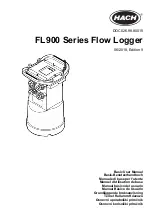
Revision 2.00 / LB-0805 – CerePlex W: Instructions for Use
14
©2019 Blackrock Microsystems®, LLC
Wireless Data Transfer
Maximum Sampling Frequency
The CerePlex W’s true sampling rate is approximately 24.5 kS/s. For this reason,
recordings using the CerePlex W system cannot record voltages at 30 kS/s even when
the sampling rate is chosen to be 30 kS/s through Central’s Hardware Configuration tool.
However, recordings from the CerePlex W collected through Central will still have data
sampled at 30 kS/s. This is accomplished through an up-sampled buffering process.
Up-sampled Buffering Process
The CerePlex W transmits recordings from up to 96 channels in a single frame.
The receiver holds this frame’s information in an output buffer that is sampled
from the NSP at 30 kS/s, and the wireless receiver will clear its output buffer
once it is sampled by the NSP. If the wireless receiver has not received a new
frame from the CerePlex W before the NSP has sampled the receiver again, the
NSP will sample the same output buffer as its previous sample, and the frame’s
information will be duplicated in the recording. This results in approximately 18%
of the data points in CerePlex W recordings to be duplicates of their
predecessors when that channel is configured to a 30 kS/s sampling rate.
Automatic Wireless Data Validation
All firmware versions of the CerePlex W and the wireless receiver have automatic
wireless data validation protocols, but these protocols differ depending on what firmware
is running on the CerePlex W and the CerePlex receiver. Contact
[email protected] to check your firmware versions.
Loss of Lock (LOL)
The wireless data sent from the CerePlex W is Manchester Encoded, which
contains rich clock frequency components in its spectrum for better facilitating
data recovery on the receiver side. Once the data is received by the receiver, the
receiver will try to recover the clock signal from the Manchester Encoded data
received by each antenna input. The ability to recover clock from the received
wireless data stream is a key requirement and indication of good signal reception
and ensures wireless communication quality and bit error rate. If the receiver can
recover clock signal from one antenna input, that antenna input channel’s
Reception Indicator LED will illuminate blue. Otherwise, that antenna input
channel’s Reception Indicator LED will not illuminate, indicating a poor signal
reception for that antenna, and the incoming data will be discarded. Antenna data
that passed the LOL check can then move to the next Frame Check process.
Frame Check (FC)
Data frames sent from the CerePlex W begin with a 24-bit sync signal and end
with a 48-bit suffix. Once a sync signal is identified, the remaining bits are read
for the frame. An inability to read the sync and suffix messages de asserts the
“FrameCheck” flag and this specific frame of data is not buffered. In this case,



































